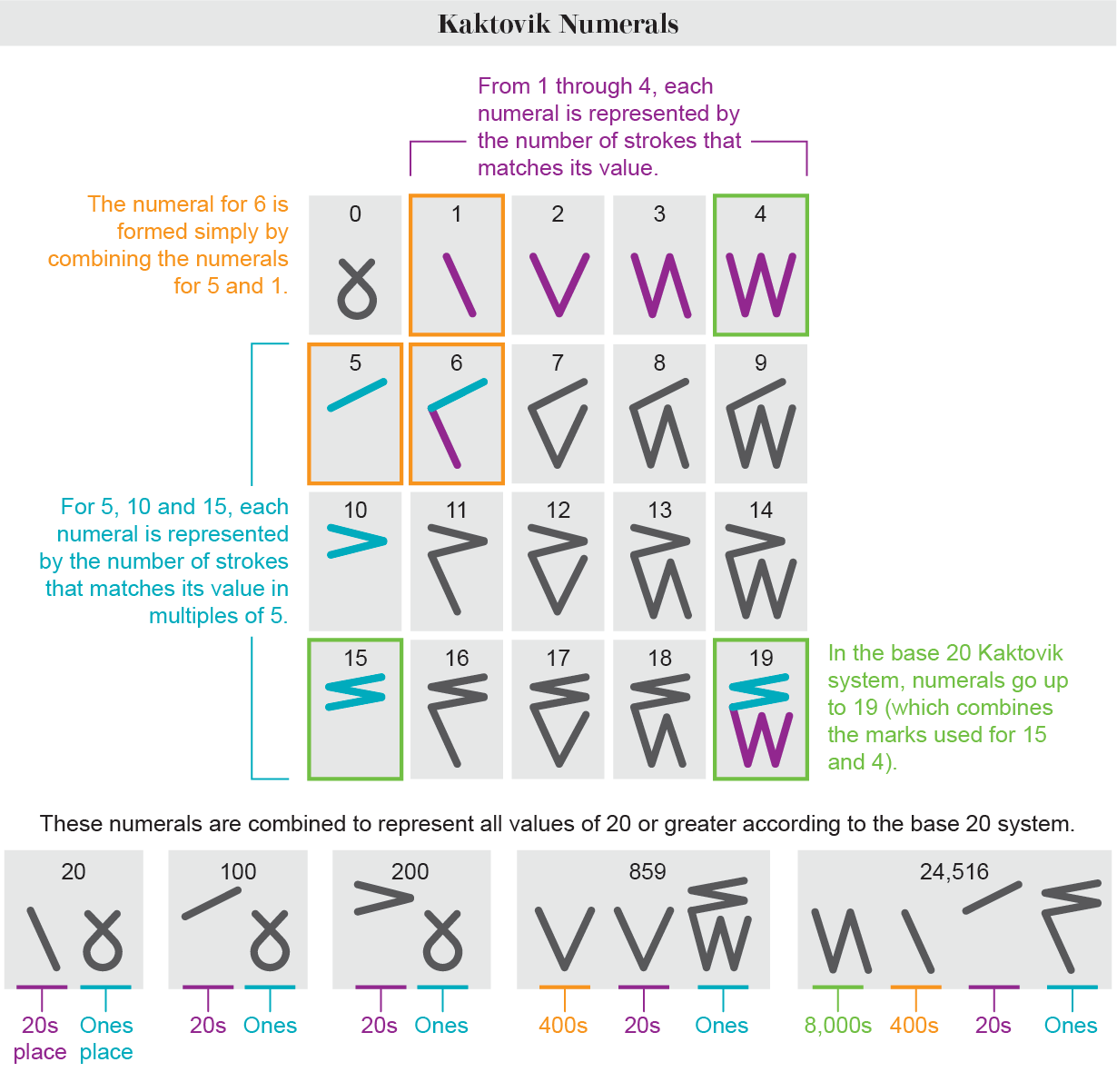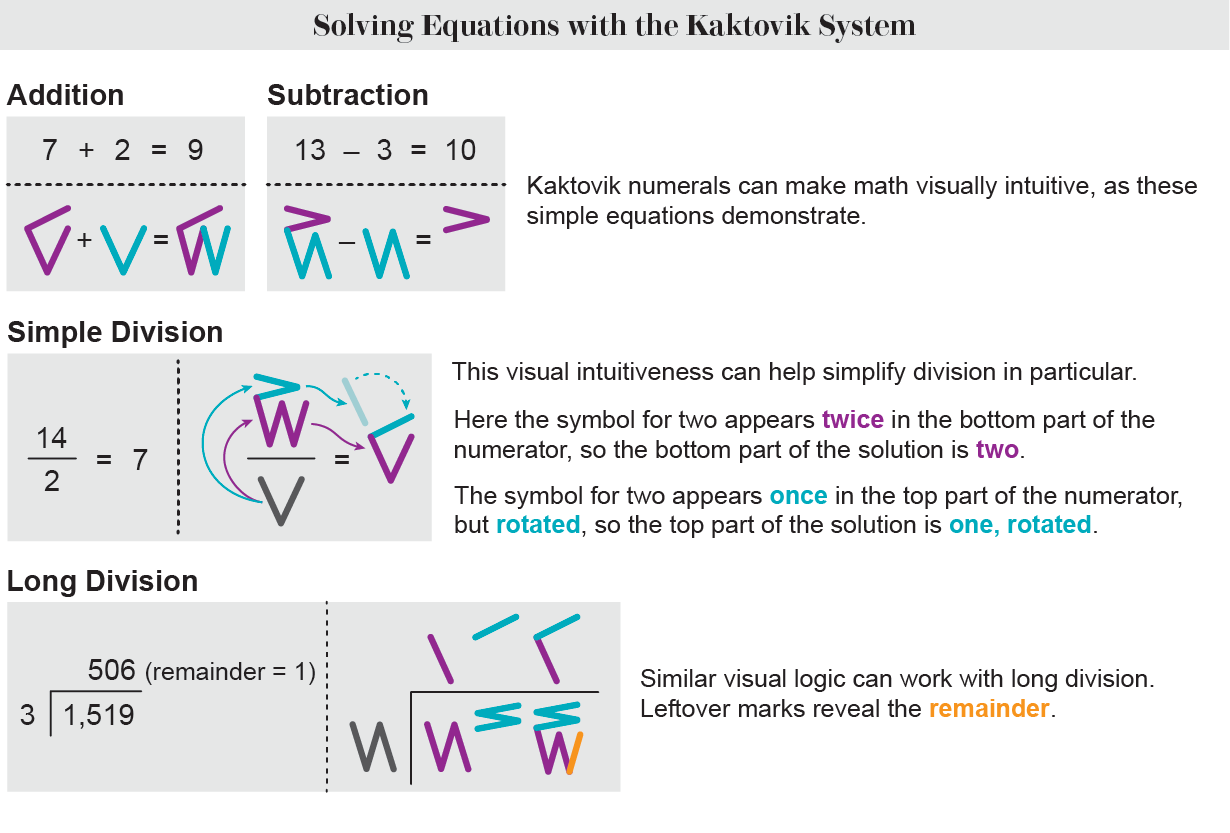Math is called the “universal language,” but a unique dialect is being reborn
In the remote Arctic almost 30 years ago, a group of Inuit middle school students and their teacher invented the Western Hemisphere’s first new number system in more than a century. The “Kaktovik numerals,” named after the Alaskan village where they were created, looked utterly different from decimal system numerals and functioned differently, too. But they were uniquely suited for quick, visual arithmetic using the traditional Inuit oral counting system, and they swiftly spread throughout the region. Now, with support from Silicon Valley, they will soon be available on smartphones and computers—creating a bridge for the Kaktovik numerals to cross into the digital realm.
Today’s numerical world is dominated by the Hindu-Arabic decimal system. This system, adopted by almost every society, is what many people think of as “numbers”—values expressed in a written form using the digits 0 through 9. But meaningful alternatives exist, and they are as varied as the cultures they belong to.
The Alaskan Inuit language, known as Iñupiaq, uses an oral counting system built around the human body. Quantities are first described in groups of five, 10, and 15 and then in sets of 20. The system “is really the count of your hands and the count of your toes,” says Nuluqutaaq Maggie Pollock, who taught with the Kaktovik numerals in Utqiagvik, a city 300 miles northwest of where the numerals were invented. For example, she says, tallimat—the Iñupiaq word for 5—comes from the word for arm: taliq. “In your one arm, you have tallimat fingers,” Pollock explains. Iñuiññaq, the word for 20, represents a whole person. In traditional practices, the body also serves as a mathematical multitool. “When my mother made me a parka, she used her thumb and her middle finger to measure how many times she would be able to cut the material,” Pollock says. “Before yardsticks or rulers, [Iñupiat people] used their hands and fingers to calculate or measure.”
During the 19th and 20th centuries, American schools suppressed the Iñupiaq language—first violently and then quietly. “We had a tutor from the village who would help us blend into the white man’s world,” Pollock says of her own education. “But when my father went to school, if he spoke the language, they would slap his hands. It was torture for them.” By the 1990s the Iñupiaq counting system was dangerously close to being forgotten.
The Kaktovik numerals started as a class project to adapt the counting system to a written form. The numerals, based on tally marks, “look like” the Iñupiaq words they represent. For example, the Iñupiaq word for 18, “akimiaq piŋasut,” meaning “15-3,” is depicted with three horizontal strokes, representing three groups of 5 (15) above three vertical strokes representing 3.

Credit: Amanda Montañez; Source: “Unicode Request for Kaktovik Numerals,” by Eduardo Marín Silva and Catherine Strand. Submitted to Unicode Technical Committee Document Registry March 16, 2021 (reference)
“In the Iñupiaq language, there wasn’t a word for 0,” says William Clark Bartley, the teacher who helped develop the numerals. “The girl who gave us the symbol for 0, she just crossed her arms above her head like there was nothing.” The class added her suggestion—an X-like mark—to their set of unique numerals for 1 through 19 and invented what mathematicians would call a base 20 positional value system. (Technically, it is a two-dimensional positional value system with a primary base of 20 and a sub-base of 5.)
Because of the tally-inspired design, arithmetic using the Kaktovik numerals is strikingly visual. Addition, subtraction and even long division become almost geometric. The Hindu-Arabic digits are an awkward system, Bartley says, but “the students found, with their numerals, they could solve problems a better way, a faster way.”

Credit: Amanda Montañez; Source: “Unicode Request for Kaktovik Numerals, by Eduardo Marín Silva and Catherine Strand. Submitted to Unicode Technical Committee Document Registry March 16, 2021 (reference)
“The Iñupiaq way of knowing is often done by showing,” adds Qaġġuna Tenna Judkins, director of Iñupiaq education in northern Alaska’s North Slope Borough. Visualizing arithmetic makes those concepts a lot easier to understand, she says.
At first students would convert their assigned math problems into Kaktovik numerals to do calculations, but middle school math classes in Kaktovik began teaching the numerals in equal measure with their Hindu-Arabic counterparts in 1997. Bartley reports that after a year of the students working fluently in both systems, scores on standardized math exams jumped from below the 20th percentile to “significantly above” the national average. And in the meantime, the board of education in the North Slope Borough’s district seat, Utqiagvik, passed a resolution that spread the numerals almost 500 miles along the Arctic coast. The system was even endorsed by the Inuit Circumpolar Council, which represents 180,000 Inuit across Alaska, Canada, Greenland and Russia.
But under the federal No Child Left Behind Act, from 2002 to 2015, schools faced severe sanctions—or even closure—for not meeting state standards, provoking a “scare” that some local educators say squeezed the Kaktovik numerals into a marginal role despite the system’s demonstrated educational impact. “Today the only place [they’re] really being used is in the Iñupiaq language classrooms,” says Chrisann Justice, the North Slope Borough’s Iñupiaq education department specialist. “We’re just blowing on the coal.”
Now support from Silicon Valley is helping to reignite the Kaktovik numerals. Thanks to efforts by linguists working with the Script Encoding Initiative at the University of California, Berkeley, the numerals were included in the September 2022 update of Unicode, an international information technology standard that enables the digitization of the world’s written languages. The new release, Unicode 15.0, provides a virtual identifier for each Kaktovik numeral so developers can incorporate them into digital displays. “It really is revolutionary for us,” Judkins says. “Right now we either have to use photos of the numerals or write them by hand.”
There is still work to be done. Google is building a font for the numerals based on the Unicode update, says Craig Cornelius, a Google software engineer who works to digitally preserve endangered languages. The company made a “prelease” of its font available for computer download in March, although it won’t appear on the Android operating system until at least late summer. Desktop and mobile keyboards with the numerals need to be produced as well.
But excitement over the traditional system’s cyber-debut is growing. “If we went to a math textbook creator and said, ‘Hey, can you build us a textbook but convert the Arabic numerals into Kaktovik numerals?’ it would be that much easier,” Judkins says.
Unicode inclusion also pushes the boundary of what is mathematically feasible with the Kaktovik numerals. At higher levels, mathematics becomes an increasingly digital discipline. The basic theory can be illustrated on a blackboard, but complex problems often need to be solved with a computer. Without digital availability, the Kaktovik numerals would be confined to their arithmetic wheelhouse at a time when the Iñupiaq language is being revitalized for broad modern use. Being able to input the Kaktovik numerals into computation engines such as WolframAlpha, Judkins says, is “going to be a game changer. You are almost going to be able to choose: Am I going to be in English, or am I going to be in Iñupiaq? And if I am in Iñupiaq, I’m using all Kaktovik numerals.”
Nearly 3,000 miles away, in Oklahoma, Unicode holds similar promise for the Cherokee community. In the early 1800s Cherokee polymath Sequoyah invented the Cherokee syllabary of written characters. “Around the same time, he also developed a number system,” says Roy Boney, language program manager for the Cherokee Nation. Cherokee numerals weren’t endorsed by the tribal government until 2012. A long history of trade with French and British settlers had meant the Hindu-Arabic numerals were already in use when Cherokee numerals were invented.
While it’s unclear if Cherokee numerals have since gained traction, Boney reports that interest in the system is growing. “We have the numbers and need to use them,” he says. “It’s been a slow roll, but we have been introducing the numbers into our education settings” and are beginning to demonstrate the community use needed for inclusion in Unicode. Once the numerals are included, Boney and his colleagues hope to create a programming language using Cherokee script and numbers.
Hindu-Arabic numerals’ ubiquity is powerful and has often come at the expense of culturally meaningful systems. But now those systems are slowly going digital, which is creating opportunities for their use that would have been unthinkable even two years ago. As Nuluqutaaq Maggie Pollock puts it: “This is just the beginning.”
- Karlston
-

 1
1



Recommended Comments
There are no comments to display.
Join the conversation
You can post now and register later. If you have an account, sign in now to post with your account.
Note: Your post will require moderator approval before it will be visible.